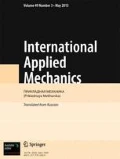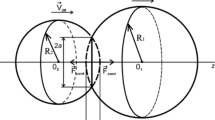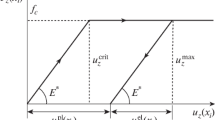Abstract
A direct central collision of two identical bodies of revolution is studied. A nonstationary mixed boundary-value problem with an unknown moving boundary is formulated. Its solution is represented by a series in term of Bessel functions. An infinite system of Volterra equations of the second kind for the unknown expansion coefficients is derived by satisfying the boundary conditions. The basic characteristics of the collision process are determined depending on the curvature of the frontal surface of the bodies
Similar content being viewed by others
REFERENCES
H. Bateman and A. Erdelyi, Higher Transcendental Functions, McGraw-Hill, New York (1953).
A. G. Gorshkov and D. V. Tarlakovskii, Dynamic Contact Problems with Moving Boundaries [in Russian], Nauka, Fizmatlit, Moscow (1995).
G. A. Korn and T. M. Korn, Mathematical Handbook for Scientists and Engineers. Definitions, Theorems, and Formulas for Reference and Review, McGraw-Hill, New York (1968).
A. A. Korobkin, Collision of Liquid and Solid Bodies [in Russian], Nauka, Novosibirsk (1997).
V. D. Kubenko, "A note on the local wave theory of collision of elastic bodies. A plane problem for a perfect fluid," Prikl. Mekh., 34, No. 10, 84-92 (1998).
V. D. Kubenko, "On one method for solving problems of penetration into an acoustic or elastic medium," in: Proc. 2nd All-Union Conf. on Problems of Dynamic Interaction of Deformable Media [in Russian], Izd. AN ArmSSR, Yerevan (1984), pp. 183-187.
V. D. Kubenko and S. N. Popov, "Axisymmetric impact of a rigid blunted body on the surface of an elastic half-space," Prikl. Mekh., 25, No. 7, 16-24 (1989).
V. D. Kubenko and S. N. Popov, "Plane impact of a rigid blunted body on the surface of an elastic half-space," Prikl. Mekh., 24, No. 7, 69-77 (1988).
P. M. Morse and H. Feshbach, Methods of Theoretical Physics, Vol. 2, McGraw-Hill, New York (1953).
R. W. Hamming, Numerical Methods for Scientists and Engineers, McGraw-Hill, New York (1962).
I. Ya. Shtaerman, "Hertz elastic collision theory revisited," {tiDAN SSSR}, 25, No. 5, 360-363 (1939).
A. L. Dmitriev, "Inequality of the coefficients of restitution for vertical and horizontal quasielastic impacts of a ball against a massive plate," Int. Appl. Mech., 38, No. 6, 747-749 (2002).
V. Z. Stankevich and M. V. Khai, "Study into the interaction of cracks in an elastic half-space under a shock load by means of boundary integral equations," Int. Appl. Mech., 38, No. 4, 440-446 (2002).
V. V. Zozulya and A. V. Men'shikov, "Contact interaction of the faces of a rectangular crack under normally incident tension-compression waves," Int. Appl. Mech., 38, No. 3, 302-307 (2002).
Author information
Authors and Affiliations
Rights and permissions
About this article
Cite this article
Kubenko, V.D., Marchenko, T.A. Axisymmetric Collision Problem for Two Identical Elastic Solids of Revolution. International Applied Mechanics 40, 766–775 (2004). https://doi.org/10.1023/B:INAM.0000046220.50305.8e
Issue Date:
DOI: https://doi.org/10.1023/B:INAM.0000046220.50305.8e




